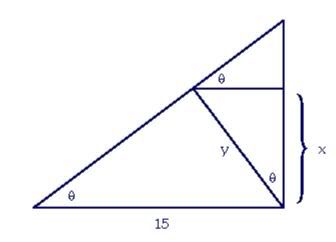curlybit89
New member
- Joined
- Sep 18, 2009
- Messages
- 3
Hello all!
I'm taking Calculus via an online course and am highly skeptical of all problems presented having personally found and confirmed 3 or 4 faulty problems (Eg a problem uses tan(3pi/6) in the denominator and the next step shows the denominator = 1).
I am taking care to record the problems that I absolutely could not understand and getting a second opinion of these problems.
Here is one of those problems now:
compute d/dx: (tan(x))/(1+x^2tan(x))
Two things come to mind, product rule and quotient rule. I am not certain about an order of operations regarding these rules go but I do see two instances of "x" in the denominator which indicates use of the product rule. Either way, my answers were wrong.
1) Quotient rule
((Sec(x)^2)+(x^2)(sec(x)^2)(tan(x) - (2x)(sec(x)^2)(tan)) / ((1+(x^2)(tan(x)))^2)
2) Product rule
((sec(x)^2))?? / ((2x)(tan(x)) + (x^2)(sec(x)^2))
----
QUESTION 2:
What is the rate of change of x with respect to Theta

Right, I see three theta. I assume somehow one is suposed to work from theta (hyp = y) to theta (adj = 15). But I have no clue on how this is done, and if done, how one would determine the length of x to remove for the end triangle.
We cannout use theta where hyp = y because as theta changes x will remain the same and will not change for a rate of change of 0.
Any guidance provided here would be immensely appreciated.
I'm taking Calculus via an online course and am highly skeptical of all problems presented having personally found and confirmed 3 or 4 faulty problems (Eg a problem uses tan(3pi/6) in the denominator and the next step shows the denominator = 1).
I am taking care to record the problems that I absolutely could not understand and getting a second opinion of these problems.
Here is one of those problems now:
compute d/dx: (tan(x))/(1+x^2tan(x))
Two things come to mind, product rule and quotient rule. I am not certain about an order of operations regarding these rules go but I do see two instances of "x" in the denominator which indicates use of the product rule. Either way, my answers were wrong.
1) Quotient rule
((Sec(x)^2)+(x^2)(sec(x)^2)(tan(x) - (2x)(sec(x)^2)(tan)) / ((1+(x^2)(tan(x)))^2)
2) Product rule
((sec(x)^2))?? / ((2x)(tan(x)) + (x^2)(sec(x)^2))
----
QUESTION 2:
What is the rate of change of x with respect to Theta

Right, I see three theta. I assume somehow one is suposed to work from theta (hyp = y) to theta (adj = 15). But I have no clue on how this is done, and if done, how one would determine the length of x to remove for the end triangle.
We cannout use theta where hyp = y because as theta changes x will remain the same and will not change for a rate of change of 0.
Any guidance provided here would be immensely appreciated.
